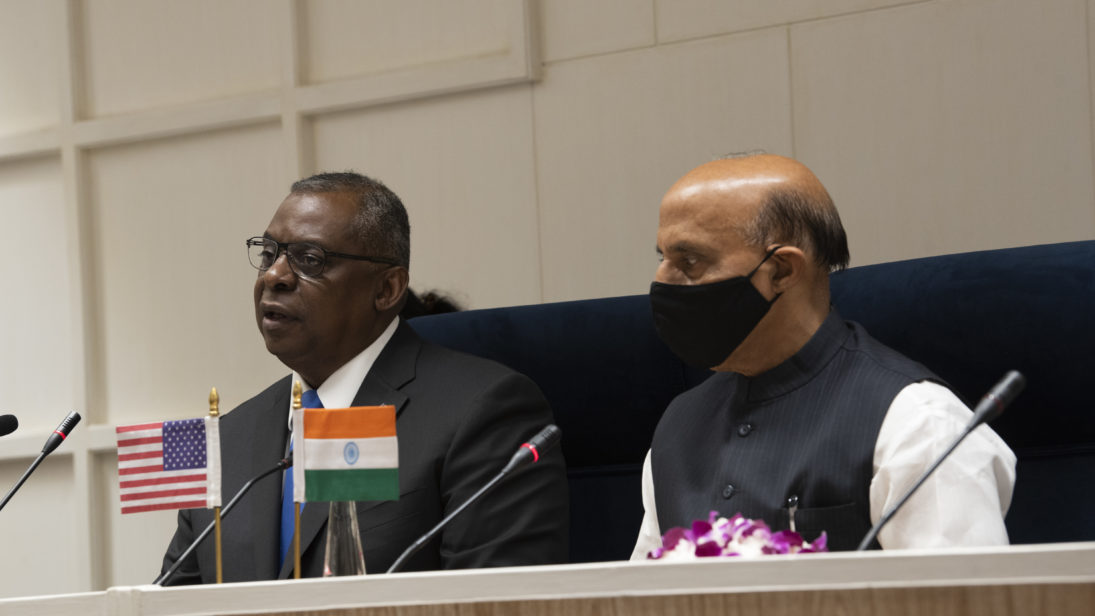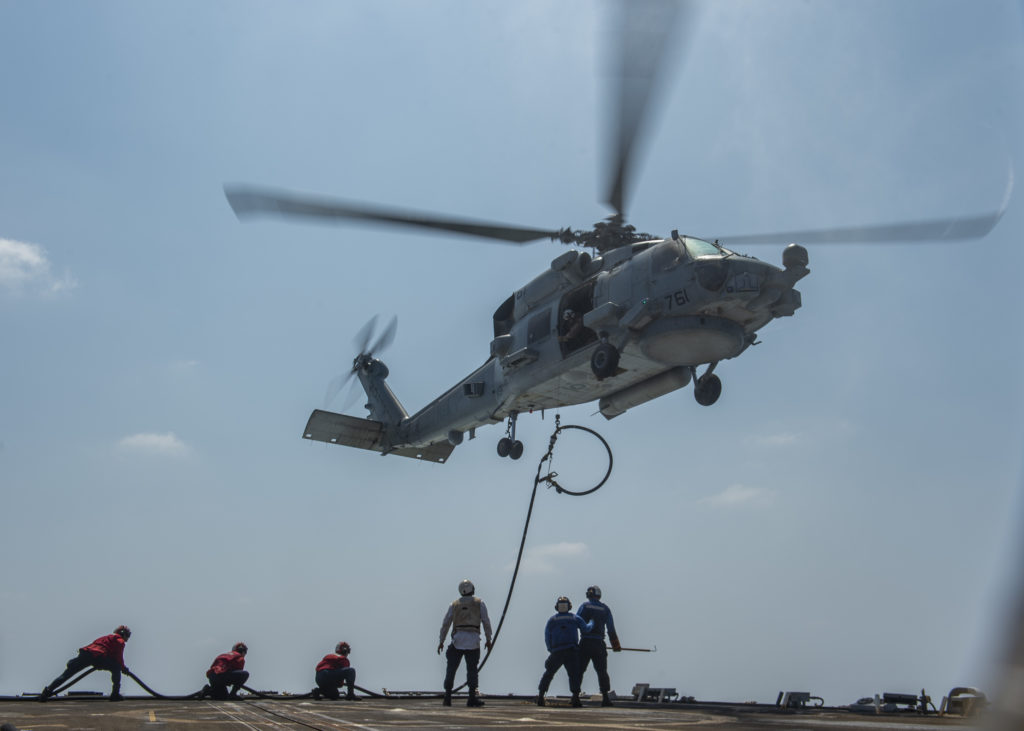
India and the United States have a multifaceted defense partnership that entails significant trade and large-scale joint military exercises. There is also a growing consensus that collaboration on emerging technologies like artificial intelligence (AI) can promote common security interests. In March 2021, U.S. Secretary of Defense Lloyd Austin discussed “the contours of sharing high-end technology” in defense with his Indian counterpart, and the two countries also formed a “Critical and Emerging Technology Working Group” as part of the Quad security dialogue along with Japan and Australia. As India and the United States look to navigate the road ahead, their bilateral collaboration in the area of AI applications for military logistics can be a pragmatic way forward.
Incentives and barriers to collaboration
The two countries have many incentives to work together on defense issues, and increasingly on military AI. India is a key U.S. partner and a potential counterweight to China in the Indian Ocean region. But as the United States reorients its focus toward strategic competition with China, one notable gap is the scarcity of formal agreements or multinational institutions to facilitate science and technology collaboration with its Indo-Pacific allies, akin to arrangements with Europe. A closer partnership with India can begin closing this gap. India, meanwhile, would benefit from U.S. support and investments in its defense technology sector. This is especially because China’s military is investing in advanced AI capabilities and increasing its presence across the China-India land border, as well as in the Indian Ocean, which is threatening India’s sovereignty and leadership position in the region. That said, collaboration on military AI can be difficult due to several reasons, including public concerns surrounding the militarization of AI, and issues in creating and maintaining interoperable systems across entities with varied defense equipment and differing practices in storing data.
The significance of tech improvements in logistics cannot be overemphasized for India — a country that faces key logistical constraints across its major battlegrounds and fears logistical vulnerabilities in handling a potential two-fronted war against China and Pakistan.
India and the United States face particular challenges. New Delhi is becoming increasingly assertive when it comes to digital sovereignty and control over its data, exacerbating the technical challenges involved in AI collaboration. Such behavior is manifested in the Indian government’s recent clashes with U.S. big tech companies over data privacy rules and its Personal Data Protection Bill that includes “forced” localization practices like in-country data storage. On the other hand, Washington’s worries pertain to the transfer of certain defense technologies where it can maintain its competitive edge, which clashes with India’s objectives of achieving self-sufficiency in manufacturing defense equipment. Both countries also have a streak of economic nationalism with each wanting to build new technologies on its own soil that could result in potentially misaligned approaches as they decide to collaborate on military AI.
AI for Military Logistics as a Pragmatic Way Forward
However, there are promising areas of collaboration in military AI that can sidestep some of these barriers. Recent research by Georgetown University’s Centre for Security and Emerging Technology shows that AI applications for military logistics and sustainment offer a technologically attainable, politically feasible, and strategically imperative area for collaboration. Military logistics is a massive enterprise, but at its core, it deals with managing the global supply chain for the armed services. One example of AI in military logistics is predictive maintenance; large amounts of data, such as aircraft maintenance records, are used to train machine learning (ML) algorithms to anticipate potential issues before they lead to breakdowns in equipment. Notably, both the Indian and U.S. militaries are already making progress in this space. High-level military officials in India have initiated work by digitizing their inventory management system and the U.S. Joint Artificial Intelligence Center (JAIC) has deployed ML tools to improve the overall quality of its H-60 helicopter fleet health reporting.
From a technological standpoint, collaboration in this area is possible because many of the logistics-relevant applications can be leveraged from the private sector as well as developed and tested in benign settings akin to commercial civilian enterprises. For the U.S. and India particularly, AI cooperation on military logistics is viable given India’s history of defense equipment procurement from the United States, which most recently includes AH-64E Apache attack helicopters for the Indian Army and MH-60R Seahawk helicopters for the Indian Navy. This common infrastructure provides ample opportunities for the two sides to experiment with building AI-enabled logistics components together without worries of equipment standardization and integration. Moreover, such collaboration offers a chance to diversify bilateral defense tech conversations, moving beyond a transactional relationship centered in defense trade towards ensuring more strategic and tactical military alignment.

Politically speaking, collaborative efforts in developing AI tools for military logistical areas, such as defense supply chain management and equipment maintenance, can sidestep the contentious “killer robot” debate. This is important considering that leading academics, AI researchers, and activists in both India and the United States have called for a moratorium on the development of autonomous weapons systems, and are more likely to raise concerns on bilateral ventures for defense tech applications that directly support combat.
There are also strategic considerations. Coordination on AI-enabled logistic systems can provide key operational advantages — for instance, through efficient movement of personnel and equipment — that significantly enhance the ability to deter and defeat adversaries if conflict erupts. For the United States, using AI to build more responsive logistics systems is important to ensure its ability to sustain combat power in the Indo-Pacific, where it has no local shore bases but a high interest in projecting strength. The significance of tech improvements in logistics cannot be overemphasized for India — a country that faces key logistical constraints across its major battlegrounds and fears logistical vulnerabilities in handling a potential two-fronted war against China and Pakistan.
Existing efforts and future directions
New Delhi and Washington understand the compelling reasons to work together on military logistics and have already come a long way by signing foundational agreements such as the Logistics Exchange Memorandum of Agreement (LEMOA) that establishes basic terms and conditions for reciprocal provision of logistical support between their armed forces. However, there is potential for more progress and several practical ways for the two countries to catalyze their military AI partnership. For instance, they can include AI-enabled logistics components into their joint bilateral military exercises like Yudh Abhyas or the Malabar naval exercise in which all members of the Quad take part.
As India and the United States look to navigate the road ahead, their bilateral collaboration in the area of AI applications for military logistics can be a pragmatic way forward.
Such drills would allow India and the United States to test and predict the technologies’ performance in uncontrolled and dynamic environments—conditions in which AI systems are known to be brittle and vulnerable to adversarial attacks. Additionally, India can participate in early-stage collaborative efforts like the JAIC’s AI Partnership for Defense that was established in 2020 as a forum for like-minded countries to share practices and coordinate on AI policy and adoption in their military. Moreover, India and the United States could facilitate joint research and exchanges for projects on military AI logistics where their research agendas and collaborative spirit in basic science align. This goal is practical and achievable because they already have significant research partnerships, with Indian AI researchers co-authoring papers with their American counterparts five times more frequently than any other country in the world.
India and the United States have strong incentives to work together on AI when it comes to military logistics. It offers a mutually beneficial area of defense cooperation that has the potential to build upon their existing research partnerships, advance their shared security interests, strengthen readiness, promote interoperability, and boost military effectiveness for the road ahead.
Editor’s Note: This piece originally appeared on 9DashLine and has been republished with permission of the editors.
***
Image 1: U.S. Secretary of Defense via Flickr
Image 2: U.S. Navy via Flickr


